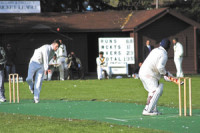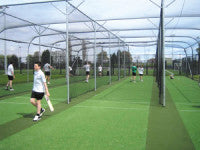Non-Turf Cricket Facilities
 Before you consider any work on a non-turf surface you must find out which system and, therefore, which construction type, you have. Most users are under the impression that there are only two types, ie. concrete or stone based, and that there is little difference in systems within those two types. That is really not the case.
Before you consider any work on a non-turf surface you must find out which system and, therefore, which construction type, you have. Most users are under the impression that there are only two types, ie. concrete or stone based, and that there is little difference in systems within those two types. That is really not the case.
Concrete Systems
There are only really two types of concrete system - those that are stuck to the base or those that are pinned to the surrounding woodwork or soil. If it has been pinned then it is probably a replacement for an old stuck down surface or a modern system on concrete. The main problem with sticking a carpet to concrete is the difficulty in replacing it - when lifted, a good proportion of the glue and carpet backing will remain firmly attached.
All this needs to be removed before a new surface can be installed. It is this issue that leads a lot of contractors to pin the surface, rather than glue it, to aid replacement at a later date. Whether the carpet has been stuck or pinned, there should never be any need to lift it unless it is severely damaged and needs replacement.
The surface should be kept as clean as possible. Grass encroaching on to the surface should be cut or strimmed back to the edges, any moss or plants that manage to establish on the surface should be physically removed and the surface then firmly brushed to remove all debris. If the surface has become severely contaminated then a pressure washer should be used to thoroughly clean the carpet pile.
When replacing carpet on concrete make sure that the work includes relevelling the concrete. Any loose material must be fully removed and the level made good, either by using a good hard adhesive filler or by refacing the concrete and using a self levelling concrete finish to renovate the surface. The last job should be to rub a carborundum stone over the whole surface to remove surface imperfections, before replacing the carpet.
Stone Base Systems
This type of construction has seen a number of variations:
1. Aggregate depth
100mm would be used for the majority of systems where fast and true bounce is required. These give a surface closest to well prepared turf pitches, but require the most maintenance. The aggregate may be encased in geotextile, bordered by wooden edging, or just laid straight into the excavated hole. The surface 50mm should be made up of hard porous stone less than 6mm in size.
50mm depth is generally used with a specially produced shockpad that spreads the impact and provides a higher degree of bounce.
It is also possible to lay these specialised shockpad surfaces directly into a level soil area, generally with a blinding layer of sand.
2. Carpets and Shockpads
The most common types of carpetting are:
Needlepunch - is a mass of fibres intertwined with each other in a random pattern. These are secured with resin bonding and the surface, in some cases, is veloured to provide a more tuft like finish. The thickness is such that the base of the fibres provides an element of shockpad, making it the ideal surface to stick down to concrete. It is used on other areas as a budget material, but is not as strong as the woven and tufted surfaces, and is particularly prone to stud wear. It is also used for the 4mm shockpad and this will help keep the aggregate surface sound and provide a truer, more consistent bounce.
Also, as a geotextile, it is less prone to clogging due to its superior pore space compared to spun-woven textiles. It is also often used as budget infill material, but becomes easily misshapen if too thin.
Tufted - as it's name implies, is made by a 'tuft' of artificial grass being pushed through a strong backing mesh several layers thick and sealed on the back. The tufted carpet is not as strong as woven, is less dense and will not, generally, last as long as woven. This surface is used for batting and bowling ends and, in several forms, as run-up carpet and infill between performance areas on higher quality installations. Should, ideally, always be fitted with a needlepunch shockpad.
Woven - this is the top quality carpet for cricket. It does, however, come in several different densities and qualities, so the price is often deceptive. It is the hardest wearing and truest of all the carpets. The tuft is woven into the backing making them virtually impossible to dislodge. Also, being woven, it allows very free drainage and the surface will not hold water. This should also be fitted with a needlepunch shockpad; a lack of a which can lead to uneven bounce and higher wear to the carpet back.
Specialist Shockpad - this usually consists of a special high density foam sandwiched between a bonded backing layer of shockpad and the surface shockpad. With performance being controlled by man-made components, the influence of compaction and weather are limited, and this leads to a lower regular maintenance requirement.
Pre Season Maintenance of Aggregate Based Match Pitches
All match pitches are laid into the turf of an outfield area, some as stand alone facilities, others adjoining a natural turf square.
By far the most important maintenance issue is the encroachment of coarse grass to the immediate surrounds. If grasses are allowed to grow unchecked then the stems will thicken tremendously and this will physically push the carpet inwards, losing the carpet's initial tension and, in the most extreme cases, causing longitudinal wrinkles. To prevent this, keep the immediate surround mown all year round at or below a 20mm cut so as not to allow the coarse grasses to get hold. Contract mown outfields are particularly prone, as the contractor will generally leave a safety margin around the strip.
If this encroachment is allowed to start covering the edges of the carpet, these will tend to be pushed down into the ground - the greater the extent of this the greater the lip when the carpet is cleared back to its edge. Prevention is by occasionally strimming or pruning this growth back to the edge.
Once the edges have been cleared the carpet needs to be cleaned of all vegetative growth and debris.
This can be removed using a strimmer or the blade of a spade, shovel or hoe, followed by a thorough brushing to clear the pile. Be extremely careful if chemically treating the weeds, glyphosate can remain active for weeks on these surfaces and picked up on feet and machinery when damp.
If the pile is heavily contaminated with moss, algae and soil, proceed as before but then use a pressure washer to clean all the muck out, allow it to dry and then brush it again.
Once the surface is completely clear, and preferably whilst the subsoil and aggregate are still moist, lightly roll the surface. This should be done with a roller ideally in the range 0.25 - 0.3 tonne but no more than 0.5 tonne. Rollers over this size will cause a bow wave of carpet and this may either dislodge the fixings or seriously damage the carpet itself when the 'fold' gets rolled.
Heavy rollers will also crush and damage the aggregate base, destroying the built in evenness of pace, so great care should be taken not to allow pre-season rolling with a heavy roller to include the non-turf pitch! The requirement is to settle any loose surface aggregate, not to consolidate. Should wrinkles persist it may be necessary to lift the pins at that end of the carpet and reposition them.
On pitches built on less aggregate, and incorporating a special shockpad, rolling should only be needed right at the start of the season to settle things down. Those on 100mm aggregate, with the carpet directly laid on top, or with an ordinary shockpad, should lightly roll the ball bounce area more regularly to maintain the pace and consistency of bounce.
If spiked footwear is to be permitted, to prolong the life of a woven carpet, fill the pile of the carpet with fine sand or soil in the bowlers delivery areas, e xtending no more than 0.50m in front of the popping crease on match pitches.
xtending no more than 0.50m in front of the popping crease on match pitches.
If stump boxes have been installed make sure there is enough soil, that all weeds have been removed, and that the high clay soil is kept moist before each use.Lines should then be remarked in accordance with the rules. This can be done using emulsion paint - ordinary line marking fluid diluted 2/3:1 does an excellent and reasonably long lasting job.
Lifting the Carpet
Once all this is done it may become obvious that the levels need adjustment - unevenness in the ball bounce area or excessive dishing of the popping crease. This is a major job and is best left to those with experience in this work.
On wooden edging it is unlikely an old carpet will come off the boards without damage and should only be attempted with replacement in mind. If you do attempt this work, make sure everything is clear and clean, that all aggregates have been resettled and that nothing gets trapped under the carpet when you put it back. Also, be careful attempting to stretch an old carpet as it may tear in half!!
Practice Facilities (nets)
All the above can be applied to practice facilities as well. In addition, make sure that the nets themselves are secure at the bottom to prevent them blowing backwards and forwards in the wind and sweeping debris into the playing area. When replacing netting ask for the roof to be stitched in - this is a small extra cost but makes putting up and taking down considerably easier, as well as greatly enhancing the safety of the facility.
About the author: Mark Hansford and GroundCare have been in business for twenty years in sports field maintenance and construction and installing artificial surfaces for the last ten. Six years ago GroundCare started using the Verde Sports (Cricket) Ltd systems at the top of their range and, two years later, satisfied Verde's quality standard to become the Southern installer of their ECB approved Test Match and Premier non-turf systems.
